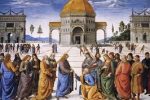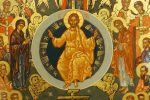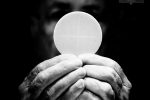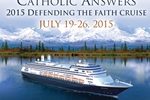Were Adam and Eve Real or Symbols?

In recent years it has become more and more in vogue to say Adam and Eve were not real historical individuals; rather, they were symbols of a population of thousands of original “parents” from whom all are descended. In a word, this is what Pope Pius XII referred to as the error of “polygenism” now reinvigorated.
The source of these rumblings can be traced to a relatively few, very few, statements of note that have been greatly exaggerated in importance. The first was from a remarkably lacking catechism published by the Dutch Bishop’s Conference in 1966. Though it called into question the historical veracity of Adam and Eve, it also taught Catholic couples to consider their consciences the final authority on contraception, and more such tomfoolery. Though, unfortunately, the bishops never rescinded that horrid document, it is not taken seriously in the Church, especially in view of the universal Catechism promulgated as a “sure norm” for the universal Church in 1992, with the final and Latin typical edition being promulgated in 1997.
Similarly, there was a German Catechism promulgated by the German Bishops in 1987 that favored polygenism. And though it was certainly a far better catechism than the Dutch catechism, it too has been superseded in authority by the Universal Catechism. It is not to be understood that the Universal Catechism replaced local catechisms, but where there is a conflict, the new Catechism of the Catholic Church represents the ordinary teaching of the Church. It is to be the standard and guide for local catechisms.
Finally, we have a vague statement followed by a parenthetical statement from the International Theological Commission that seem favorable to “polygenism” as well. And it is important to note that the Commission was chaired by then Cardinal Joseph Ratzinger, now Pope Emeritus Benedict XVI, at the time. The document, Communion and Stewardship: Human Persons Created in the Image of God, published in 2004, acknowledges that the scientific evidence seems to point to a polygenic origin for humanity. It states:
While the story of human origins is complex and subject to revision, physical anthropology and molecular biology combine to make a convincing case for the origin of the human species in Africa about 150,000 years ago in a humanoid population of common genetic lineage (Para. 63).
And here is the parenthetic statement (Para. 70).
Catholic theology affirms that that the emergence of the first members of the human species (whether as individuals or in populations) represents an event that is not susceptible of a purely natural explanation and which can appropriately be attributed to divine intervention.
While these are significant statements to be sure, they are greatly exaggerated in importance in some circles today. The International Theological Commission does not have magisterial authority in the Catholic Church. It is merely advisory in nature. Unless it is quoted by the Magisterium in an authoritative document, it retains its advisory character, and nothing more. These statements have not been so quoted, and therefore do not overrule the teaching of the Ordinary Magisterium on this matter, nor do they reduce the earlier Magisterial statements in any way.
One note of import before we get to the Magisterial statements of the Church: For those who struggle with the scientific issues that surround the consideration of Adam and Eve as real historical persons, they and we are free to ask questions respectfully concerning these often perplexing questions. But out of respect for the Ordinary Magisterium, we must acknowledge that the teaching of the Church is that we have two original parents, Adam and Eve. In this post, I would like to do two things. First, I want to make clear what the teaching of the Church is. And second, I want to give some of the crucial reasons why the Church teaches as she does.
What Does the Church Teach?
In CCC 388, the Catechism footnotes Romans 5:12-21 with regard to original sin, and will refer to it again in the main text later. I believe this text alone proves devastating to polygenism:
Therefore as sin came into the world through one man and death through sin, and so death spread to all men… Adam, who was a type of the one who was to come… for if many died through one man’s trespass, much more… the free gift of grace of that one man Jesus Christ abounded for many. And the free gift is not like the effect of that one man’s sin. For the judgment following one trespass brought condemnation, but the free gift following many trespasses brings justification. If, because of one man’s trespass, death reigned through that one man, much more will those who receive the abundance of grace and the free gift of righteousness reign in life through the one man Jesus Christ.
Then as one man’s trespass led to condemnation for all men, so one man’s act of righteousness leads to acquittal… For as by one man’s disobedience many were made sinners, so by one man’s obedience many will be made righteous…
It is more than just difficult to see how St. Paul could have been clearer. The parallels drawn, the typology, is remarkable. St. Paul repeats over and over again, “as one man’s trespass… so one’s man’s act of righteousness.” To say Adam was really not a single man seems to contradict the clear teaching of the Holy Spirit through St. Paul.
Moreover, the Catechism of the Catholic Church 402-403 references this very text from Romans 5 and says:
All men are implicated in Adam’s sin, as St. Paul affirms: “By one man’s disobedience many (that is, all men) were made sinners”: “sin came into the world through one man and death through sin, and so death spread to all men because all men sinned.” The Apostle contrasts the universality of sin and death with the universality of salvation in Christ. “Then as one man’s trespass led to condemnation for all men, so one man’s act of righteousness leads to acquittal and life for all men.” Following St. Paul, the Church has always taught that the overwhelming misery which oppresses men and their inclination towards evil and death cannot be understood apart from their connection with Adam’s sin and the fact that he has transmitted to us a sin with which we are all born afflicted, a sin which is the “death of the soul”.
CCC 390 is even more compelling and comes under the heading “How to Read the Account of the Fall.” This is the Magisterium’s way of saying, among other things, “this is the way we view Adam and Eve.” It refers to one man and one woman. The Church, thus, considers this to be part of our Catholic Faith, at the very least, at the ordinary level.
The account of the fall in Genesis 3 uses figurative language, but affirms a primeval event, a deed that took place at the beginning of the history of man. Revelation gives us the certainty of faith that the whole of human history is marked by the original fault freely committed by our first parents.
There seems to be no room here for either “many men” (polygenism) or “many trespasses,” as would have to be the case for polygenism to be true. St. Paul seems quite clear, as does the Catechism.
And most importantly, footnote 365 in paragraph 390 is crucial as well. The Catechism footnotes Humani Generis, 37, where Pope Pius XII is also quite clear that polygenism is not safe to teach as Catholics:
When, however, there is question of another conjectural opinion, namely polygenism, the children of the Church by no means enjoy such liberty. For the faithful cannot embrace that opinion which maintains that either after Adam there existed on this earth true men who did not take their origin through natural generation from him as from the first parent of all, or that Adam represents a certain number of first parents. Now it is in no way apparent how such an opinion can be reconciled with that which the sources of revealed truth and the documents of the Teaching Authority of the Church propose with regard to original sin, which proceeds from a sin actually committed by an individual Adam and which, through generation, is passed on to all and is in everyone as his own.
According to the Catechism this warning is still in effect.
It also footnotes Pope Paul VI and his Allocution to a symposium on original sin, of July 11, 1966. He lays out parameters beyond which the invitees were not permitted to tread, in keeping with the teaching of Pope Pius XII and St. Paul:
With a conviction, therefore, that the doctrine of original sin—with regard to its existence and universality, and also its nature as a true sin, even in Adam’s descendants, and its sad consequences for soul and body—is a truth revealed by God in various passages of the Old and New Testament—and especially in Genesis 3:1-10, and in the Letter to the Romans 5:12-19, with which you are very familiar—you should take the greatest possible care, in delving into the meaning of the biblical texts and spelling it out more clearly, to stick to the indispensable norms which come from the analogia fidei, from the declarations and definitions of the above-mentioned Councils, and from the documents issued by the Apostolic See. In this way, you will be sure to respect… the sense of the Universal teaching Church and learning Church, which the Fathers of the Second Council of Carthage—which dealt with original sin against the Pelagians—regarded as “regulam fidei.”
Thus it is obvious that you will regard the explanations of original sin given by some modern authors as irreconcilable with genuine Catholic doctrine. Starting out from the undemonstrated hypothesis of polygenism, they deny, more or less clearly, that the sin from which this great trash heap of ills in mankind is derived, was first of all the disobedience of Adam, “the first man,” a figure of the man to come—a sin that was committed at the beginning of history. As a consequence, such explanations do not agree with Sacred Scripture, Sacred Tradition, and the Church’s magisterium, according to which the sin of the first man is transmitted to all of his descendants not through imitation but through propagation…
The theory of evolution will not seem acceptable to you whenever it is not decisively in accord with the immediate creation of each and every human soul by God, and whenever it does regard as decisively important for the fate of mankind the disobedience of Adam, the universal first parent.
In the words chosen by the Church in the Catechism as well as in its footnoting these texts, the Church has made clear that this is, at the very least, still the teaching of the Ordinary Magisterium of the Church.
As far as the compatibility of polygenism with the teaching of the Church, no one that I know of has presented a way in which it can be done. Some claim they have, but those who make the claim fall short of accomplishing the task. But even more importantly, the Magisterium of the Catholic Church has not acknowledged that it can be done.
Here are just a relatively few, seven, of the problems polygenism presents beyond the obvious ones I have already mentioned, and the Popes have already mentioned (the “one man,” “one trespass” problem, the problem of the one Adam as a figure of the one man, Christ, etc.). And this is by no means intended to be an exhaustive list.
1. If there were of necessity somewhere around 14,000 “original parents”, as some would say it would require for mankind to have a sufficient diversity of gene pool to survive (at the very least we are talking about “thousands” of original “parents” according to the varying evolutionary theories), what would this say of human nature? All 14,000 “freely” chose to commit original sin? This presents a very dark understanding of human nature. Not one of them would refuse to commit sin? Especially given the fact that our original parents’ were created in a state of perfect integrity, or “original justice,” free from the concupiscence of original sin, illuminated with extraordinary knowledge of both God and the world, in perfect harmony with God and the world, this would seem to be a more Calvinist view of human nature in relation to God than a Catholic view.
2. How would this sin be accomplished? You would have to have a certain number of babies in the womb and children under the age of accountability at the time of the commission of the original sin. If “the Teaching Authority of the Church propose[s,] with regard to original sin, [that it] proceeds from a sin actually committed by an individual Adam” (Pius XII, Humani Generis, 37), or, as CCC 404 teaches, original sin was a “a personal sin” for our original parents alone, how could babies in the womb commit this personal sin? Would each of these also have to choose to freely sin later on? How would this be one sin? And this is not to mention that this would represent an even darker view of human nature. Our original parents would have hardly been free if the commission of this first sin, or these thousands of first sins, was this automatic.
3. Now, either those babies and persons under the age of accountability would have had to commit sin later (and then we have the problem of “many original sins”), or there would have to be another class of people not considered before in our theology. You would have the thousands of original parents who somehow sinned, let’s say, by joining with their chief of their tribe in this “original sin,” and then you would have the babies and children under the age of accountability who would have somehow contracted original sin neither by actual sin nor by propagation. Would the child of five have immediately gone from a state of original justice to a state of original sin all of the sudden and through no fault of his own?
This, first of all, just seems absurd, but more importantly it would seem to contradict the teaching of the Catholic Church at the Council of Trent, Session 5, in its Decree on Original Sin, canon 1:
If any one does not confess that the first man, Adam, when he had transgressed the commandment of God in Paradise, immediately lost the holiness and justice wherein he had been constituted; and that he incurred, through the offence of that prevarication, the wrath and indignation of God, and consequently death, with which God had previously threatened him, and, together with death, captivity under his power who thenceforth had the empire of death, that is to say, the devil, and that the entire Adam, through that offence of prevarication, was changed, in body and soul, for the worse; let him be anathema.
These many “Adams” in the womb or under the age of accountability would have never “transgressed the commandment of God,” and yet they would be our “original parents?” Not according to this definition at the Council of Trent.
Again, that is absurd and, it seems to me, contrary to the Faith.
4. What of the role of “Adam” and “Eve” in the commission of original sin? St. Paul tells us Adam played the decisive role in Romans 5:12-19, but that the woman had an integral role to play as well. She was the intercessor, and as such, “first” in the transgression and deceived by the devil, who brought the message of death to her husband, according to I Tim. 2:12-14. Would we now have to have thousands of Adams and thousands of Eves with all of these women being deceived as St. Paul teaches and bringing this temptation to their husbands? And every single one of them falling in the same way? This seems, again, to be contrary to what we know of the essential goodness of human nature.
5. One way of attempting to harmonize original sin and polygenism is to say that just as Adam and Eve committed together not two sins, but one original sin with Eve contributing through her intercession toward her husband as a sort of prime mover to sin, and Adam being the one ultimately responsible as head of the family, all of the other thousands of original parents could be like Eve and participate in that sin and you would have one chief of the tribe who would hold ultimate responsibility while all participate in that sin like the fictional “Eve” in Scripture. The problem here is that you then have multiple Adams and multiple Eves all acting in the role of Eve. You have one Adam and a whole slew of Eves including men acting in the role of Eve. This too seems absurd.
6. Here is a point I think a lot of folks miss. Even if polygenism were “proven science,” which it is not, it makes unnecessary assumptions from the data received even if it were true. For example, scientists tell us that the diversified genetic pool we see in all of mankind must come from natural sources over a very long period of time. And this is understandable using the scientific method. For every natural effect, the scientist must look for a natural cause. But when it comes to the creation of the human person, there would have been no natural first cause because, for one reason, man has a spiritual element to his nature. The soul was directly and immediately created by God.
Moreover, when it comes to the human body, we know, by faith, that God did not create Adam and Eve’s human body over a long period of time. In the instant God breathed the soul into each of our original parents, they became human persons, not before. And they were not monkeys with human souls either. Even if the human body were created from “pre-existent and living matter,” as Pius XII posited as a possibility in Humani Generis 36, though this is not proven to be the case, there would have been a substantial change to that “pre-existent and living matter” so that the material into which God infused a human soul would be substantially different than it was before the soul was infused. The entire human person of Adam and the entire human person of Eve would have been created anew at the instant of the infusion of the human soul, including their bodies. God would, it seems to me, have created whatever genetic information was necessary for humanity to thrive. Whether God used “the slime of the earth,” or he used “pre-existing living matter,” he would have formed it and changed it in a substantial sense into a brand new creation.
Would these first human bodies have had some of the properties of the “slime” or the “living matter?” Absolutely! In fact, whether God used “slime” or “pre-existent living matter,” that matter would have had to have been prepared sufficiently by God for it to be capable to instantiate a human soul. But in either case, it would also have been substantially more after God breathed a soul into it than it was before. There is no possible way an evolutionary process could create a truly human body precisely because a human body only becomes a human body because it is formed by a human soul directly and immediately created by God.
Those who hold to the polygenic understanding end up positing that two different souls, one rational, and one material–a man’s and a monkey’s–could form the same body. I know I’ve used the term “absurd” a lot here, but if I may, I’ll use it one more time. That’s absurd and fails to understand the Catholic concept of the soul as the form of the body. The soul can only form one body, just as the body can only be formed by one soul.
We are not “ghosts in a machine,” folks!
7. Those who posit the possibility of a Christian view to include polygenism fail to consider the reality of what Pope St. John Paul II called the “ontological leap” from non-rational living matter (or from non-living matter as well) to a rational human being. In his famous “Message to the Pontifical Academy of Sciences: On Evolution,” St. John Paul said it like this, in paragraphs 5 and 6:
It is by virtue of his eternal soul that the whole person, including his body, possesses such great dignity. Pius XII underlined the essential point: if the origin of the human body comes through living matter which existed previously, the spiritual soul is created directly by God (“animas enim a Deo immediate creari catholica fides non retimere iubet”). (Humani Generis)
As a result, the theories of evolution which, because of the philosophies which inspire them, regard the spirit either as emerging from the forces of living matter, or as a simple epiphenomenon of that matter, are incompatible with the truth about man. They are therefore unable to serve as the basis for the dignity of the human person.
With man, we find ourselves facing a different ontological order—an ontological leap, we could say. But in posing such a great ontological discontinuity, are we not breaking up the physical continuity which seems to be the main line of research about evolution in the fields of physics and chemistry?
The answer is, “yes!” Because when it comes to the creation of man, we are not talking about monkeys with souls. We are talking about that “ontological leap” which represents a leap tantamount to a leap not just of 100 billion light years across the known universe. It is much more than that. It is more like a leap from an ant to an angel. It is a leap, both at the level of the human body and the human soul, that is impossible to make apart from a special act of an infinitely powerful and loving God.
When you read the disturbing theories that are out there, up to and including the possibility that our original “parents” could have been a mish-mosh of marriages (or some sort of “unions”) between human beings and these sub-human globs of genetic information that contributed to our genetic code, it becomes nightmarish. Monkeys mating with humans is so far beyond the pale that it hardly merits a mention in my way of thinking.
And all because those involved don’t understand what John Paul called that “ontological leap” that represents everything we are as human beings.






